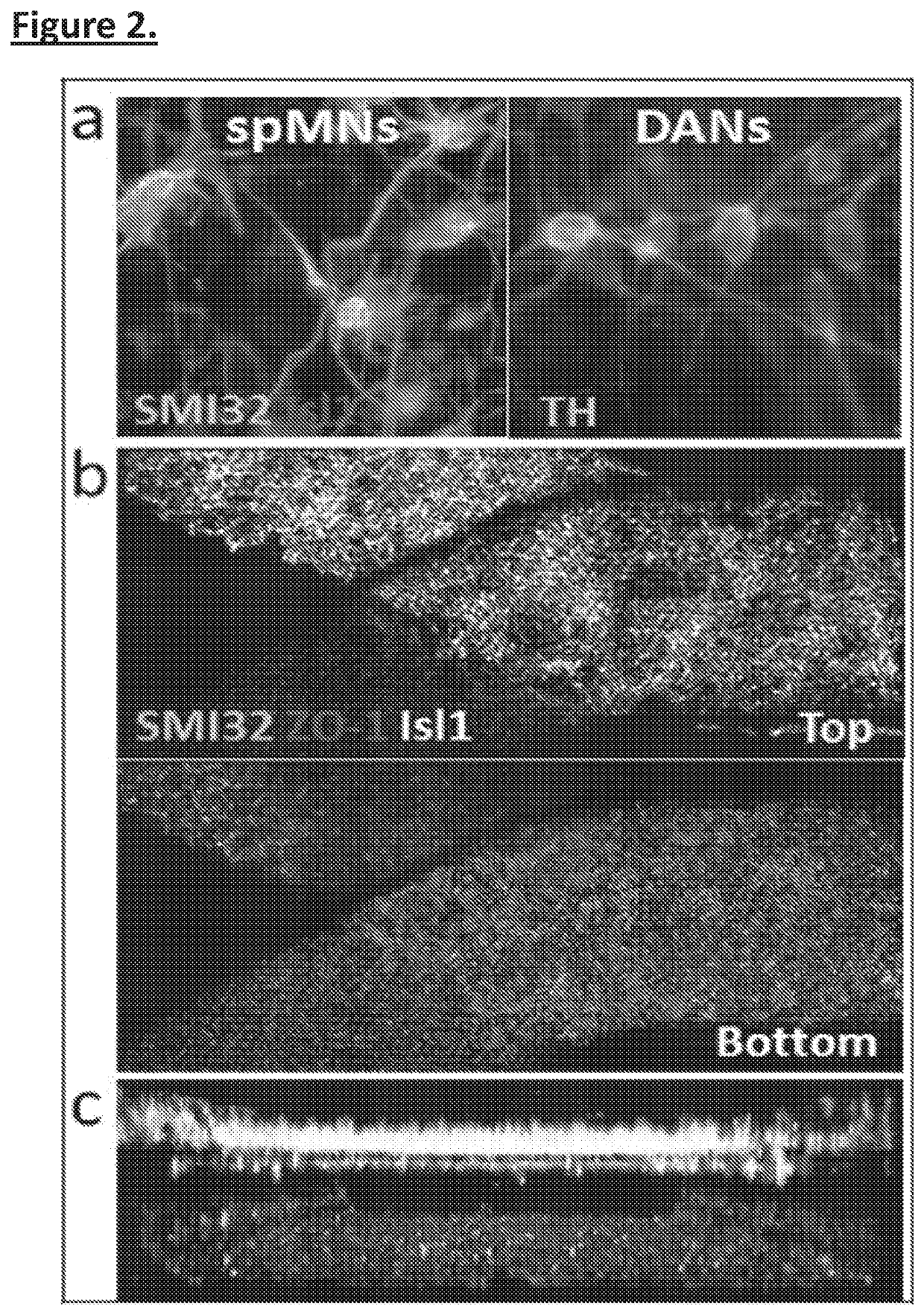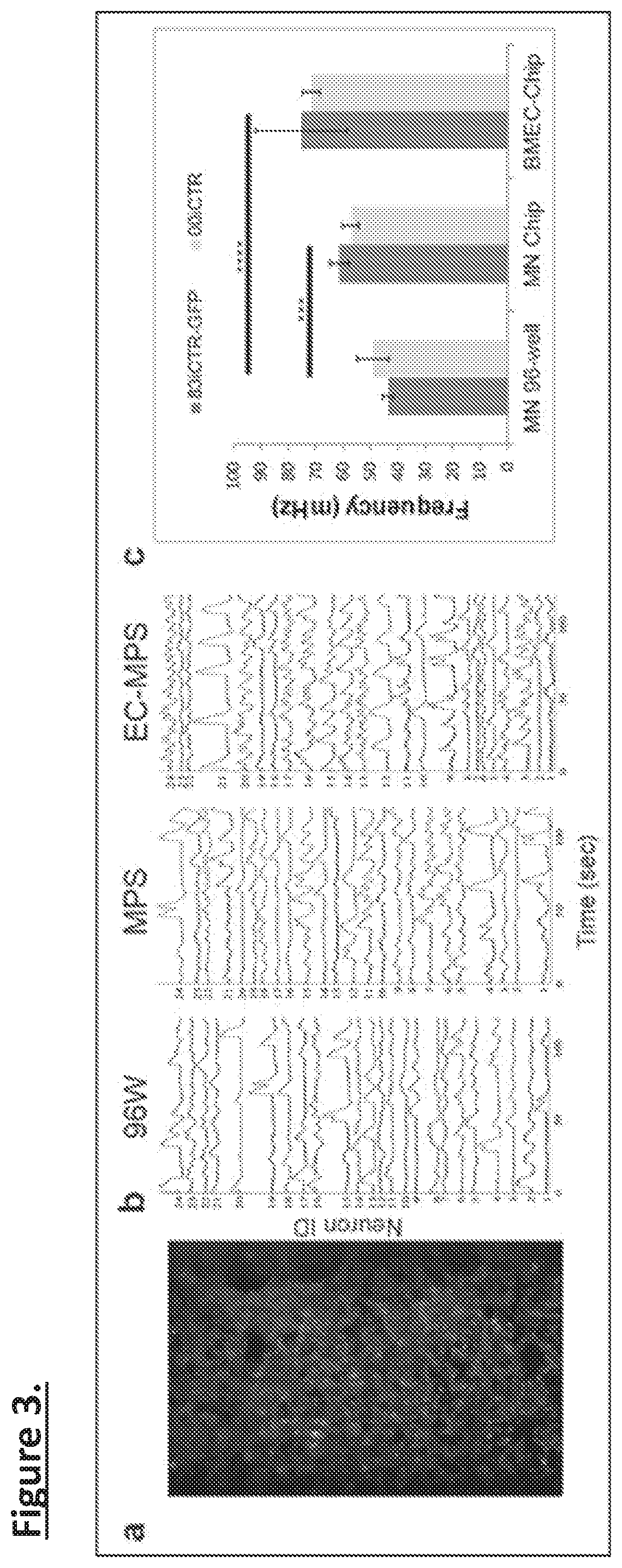Human pluripotent stem cell derived neurodegenerative disease models on a microfluidic chip
a microfluidic chip and neurodegenerative disease technology, applied in the field of cell culture, can solve the problem of no models that include human vascular components
- Summary
- Abstract
- Description
- Claims
- Application Information
AI Technical Summary
Benefits of technology
Problems solved by technology
Method used
Image
Examples
example 1
Preliminary Data
[0092]Organ-chips allow for MPS models of several organ and tissue systems, including the lung alveolus and small airway, intestine, liver, kidney, and blood-brain barrier and other organs. Organ-chips can be scaled-up while operating in parallel, and can be paired specially developed instruments to eliminate the need for the user to connect and disconnect tubing, reduce fluid dead-volumes to improve sampling, and remove undesired bubbles. These advantages increase experimental throughput, and reducing variability (FIG. 1).
[0093]Biological material on organ-chips include induced pluripotent stem cells (iPSCs), iPSC-derived cells and tissue. With a simple blood sample taken in the clinic, one can derive iPSC lines that carry the donor's genetic makeup. The patient's peripheral blood mononuclear cells (PBMCs) are directly reprogrammed, without the need for an expansion step, using non-integrating techniques that allow for transient ectopic expression of reprogramming f...
example 2
[0097]Development of Reliable APS Models of Control iPSC-Derived MNs and DANs
[0098]Prior studies by the Inventors seeding neural and endothelial cells with MPS devices described above has shown that both spMNs and DANs can differentiate in co-culture with BMECs seeded into the opposite channel. Without being bound by any particular theory, it is believed that addition of astrocytes and microglia will strengthen the model further. For example, Microglia are also a cell type that has been implicated in neurodegenerative disease and is known to lose function in traditional forms of culture. The MPS could therefore allow this cell type display novel biological and disease related physiology for the first time in vitro.
[0099]Initial studies have included seeding organ-chip with iPSC-derived astrocytes in the neural side and BMECs in the blood side 1-week prior to seeding neurons. Preliminary results indicate that the astrocyte layer increases stability of both the neural and blood compar...
example 3
Use Astrocytes and Microglia to Enhance Potential Biomarkers Through Maturation of spMN and DANs
[0101]Either spMNs or DANs are cultured in chips under 4 different conditions: (i) neurons alone in the top channel (ii) neurons in top channel with BMEC in the bottom channel (as in FIG. 2). (iii) neurons seeded into chips pre-coated with astrocytes in top channel and BMEC on bottom channel and (iv) neurons and microglia (FIG. 5) seeded into chips pre-coated with astrocytes in the top channel and BMECs in the bottom channel. One can produce microglia using a cytoplasmic florescent reporter line under a constitutive promoter so that one can determine their persistence in the cultures. This overcomes difficulties characterizing these cells with specific markers. Both channels can have 10 μl flow rates, which appear to be optimal for neural and endothelial cell survival.
[0102]Cultures are analyzed at either 2 weeks or 4 weeks post-seeding to establish how the co-cultures mature over time in...
PUM
| Property | Measurement | Unit |
|---|---|---|
| concentrations | aaaaa | aaaaa |
| flow rates | aaaaa | aaaaa |
| time-to-therapeutic effect | aaaaa | aaaaa |
Abstract
Description
Claims
Application Information
 Login to View More
Login to View More - R&D
- Intellectual Property
- Life Sciences
- Materials
- Tech Scout
- Unparalleled Data Quality
- Higher Quality Content
- 60% Fewer Hallucinations
Browse by: Latest US Patents, China's latest patents, Technical Efficacy Thesaurus, Application Domain, Technology Topic, Popular Technical Reports.
© 2025 PatSnap. All rights reserved.Legal|Privacy policy|Modern Slavery Act Transparency Statement|Sitemap|About US| Contact US: help@patsnap.com



